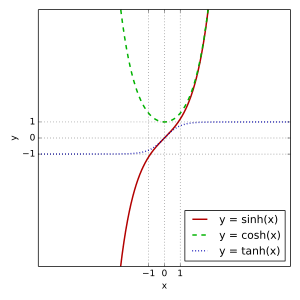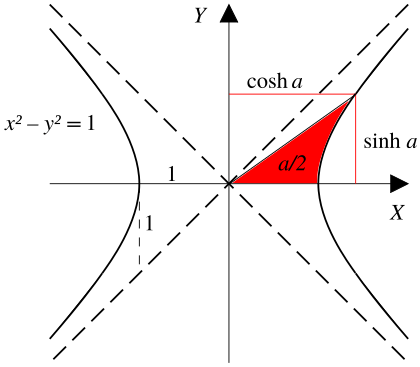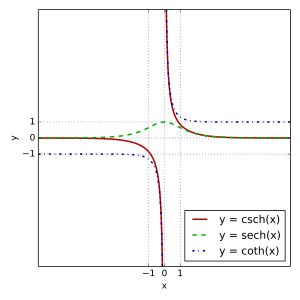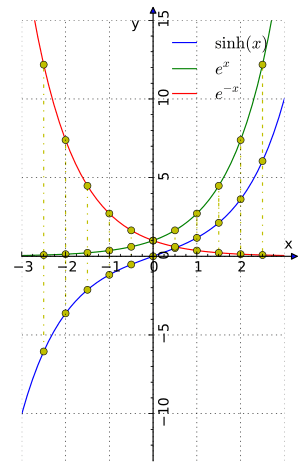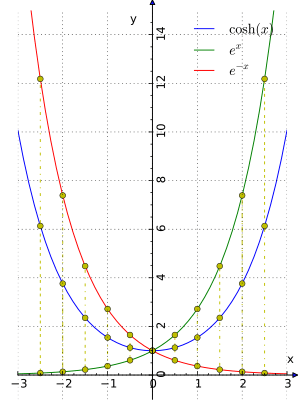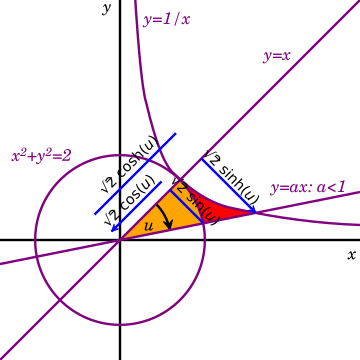Hyperbolic functions facts for kids
In mathematics, hyperbolic functions are special functions that are similar to the regular trigonometric functions you might know, like sine and cosine. But instead of being based on a circle, they are based on a hyperbola.
Think of it this way: points on a circle can be described using `(cos t, sin t)`. In the same way, points on a hyperbola can be described using `(cosh t, sinh t)`.
These functions are used in many areas of physics and math. For example, they help solve certain types of differential equations and are important in hyperbolic geometry, which is a different kind of geometry than the one you usually learn.
Contents
Meet the Hyperbolic Functions
There are six main hyperbolic functions, just like there are six main trigonometric functions.
- Hyperbolic sine (pronounced "sinch" or "shine"), written as sinh
- Hyperbolic cosine (pronounced "kosh"), written as cosh
- Hyperbolic tangent (pronounced "tansh" or "than"), written as tanh
- Hyperbolic cosecant (pronounced "koh-seech" or "koh-shek"), written as csch or cosech
- Hyperbolic secant (pronounced "seech" or "shek"), written as sech
- Hyperbolic cotangent (pronounced "koh-tansh" or "koh-than"), written as coth
There are also inverse hyperbolic functions, which work backward. For example, "arsinh" (or "sinh−1") finds the hyperbolic angle when you know its hyperbolic sine.
These functions take a real number as their input, which is called a hyperbolic angle. The size of this angle is related to the area of a special part of the hyperbola called a hyperbolic sector.
Hyperbolic functions were first introduced by mathematicians Vincenzo Riccati and Johann Heinrich Lambert in the 1760s.
How Hyperbolic Functions are Defined
You can think of hyperbolic functions in a few ways. One common way is using the exponential function, which is `e` raised to a power.
Using Exponential Functions
The most basic hyperbolic functions, sinh and cosh, are defined using the exponential function `e^x` and `e^-x`.
- Hyperbolic sine (sinh):
* This is half the difference between `e^x` and `e^-x`. * 
- Hyperbolic cosine (cosh):
* This is the average (or half the sum) of `e^x` and `e^-x`. * 
From these two, the others are found:
- Hyperbolic tangent (tanh):
* 
- Hyperbolic cotangent (coth): (for `x` not equal to 0)
* 
- Hyperbolic secant (sech):
* 
- Hyperbolic cosecant (csch): (for `x` not equal to 0)
* 
Useful Rules and Relations
Hyperbolic functions have many rules, or "identities," that are very similar to the rules for regular trigonometric functions.
Odd and Even Functions
Some functions are "even" (meaning `f(-x) = f(x)`) and some are "odd" (meaning `f(-x) = -f(x)`).
- `sinh (-x) = -sinh x` (sinh is an odd function)
- `cosh (-x) = cosh x` (cosh is an even function)
Because of this:
- `tanh (-x) = -tanh x` (odd)
- `coth (-x) = -coth x` (odd)
- `sech (-x) = sech x` (even)
- `csch (-x) = -csch x` (odd)
Key Identities
One of the most important rules for hyperbolic sine and cosine is:
This is very similar to the famous trigonometric identity `cos^2 x + sin^2 x = 1`.
Other useful rules include:
Comparing with Circular Functions
Hyperbolic functions expand on the idea of trigonometry. Regular trigonometric functions are based on a unit circle, while hyperbolic functions are based on a unit hyperbola.
Both types of functions depend on an "angle" or a value related to an area. For a circle, the area of a sector helps define the circular angle. For a hyperbola, the area of a hyperbolic sector helps define the hyperbolic angle.
Connection to the Exponential Function
The exponential function `e^x` can be split into its "even" and "odd" parts. When you do this, you get the hyperbolic cosine (the even part) and the hyperbolic sine (the odd part)!
This is similar to Euler's formula for complex numbers, which connects the exponential function to regular sine and cosine:
See also
 In Spanish: Función hiperbólica para niños
In Spanish: Función hiperbólica para niños


